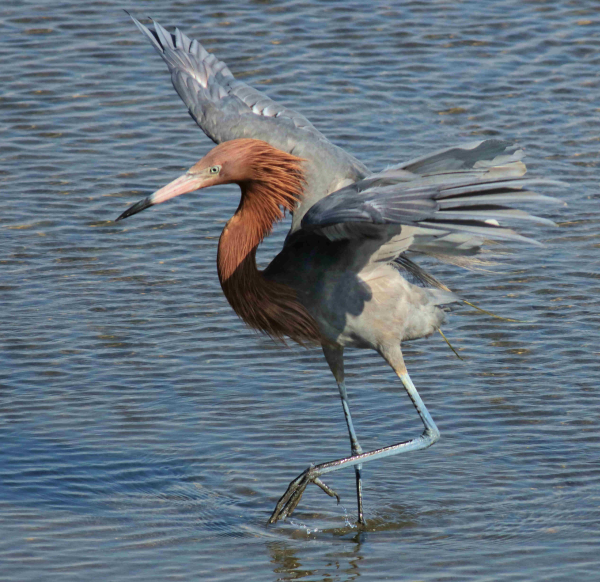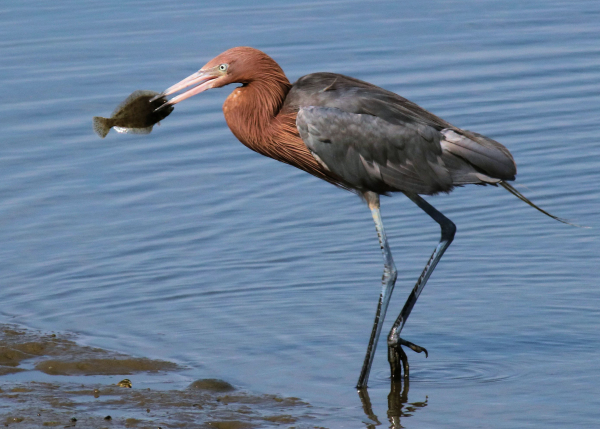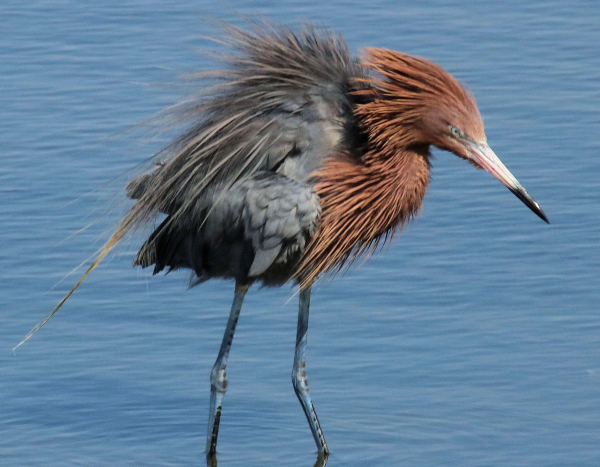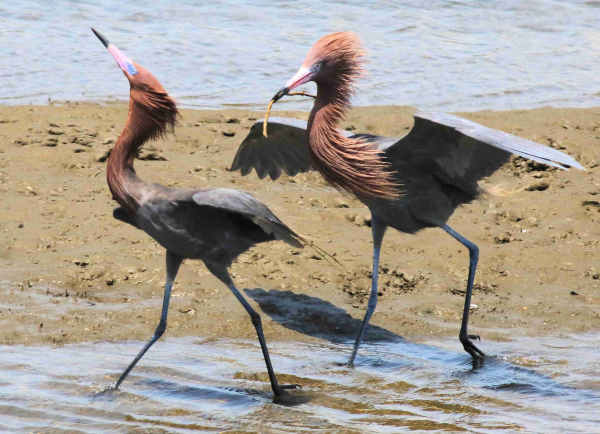Above all other wading birds, Reddish Egrets can capture people’s attention through their animated feeding activities and their mating displays. To really appreciate Reddish Egrets, you need to be close to them, and they need to be animated. A bird that may appear to be just another tall gray heron in the distance, can quickly change that perception when it flies in to land within 30 feet of you. Then, the rufous-pink coloration becomes obvious and their behavior will quickly define them.

Suddenly this impressive wading bird will begin stalking the shallows with quick steps that turn into a trotting gait as the egret raises its feet out of the water, then suddenly spins to one side with its wings half-spread for balance and its attention directed downward, its neck cocked for a strike. Then it swings back in the other direction, seemingly prancing through the water with spray flying. As the hunt continues it seems the egret is doing more dancing than hunting. All the action lends itself to super opportunities for action photography – if you are positioned in the right spot with the right light.
As with any photo subject, move to a location where the light is at your back with the egret in front of you. If you can get to a slightly elevated location, sometimes that can be helpful. If you can follow the egret, which is usually on the move, that’s your best option. Usually, we must take advantage of what nature offers, but keep these thoughts in mind.

As with any action photo opportunities, do your best to favor the fastest shutter speed possible. If necessary, you can reduce your aperture to an f6 or so, which should provide plenty of area in focus, but if you have plenty of light, use an f-stop of f8, which I consider normal when using a telephoto or zoom lens. If you can keep your shutter speed above 1/1,000 of a second, you should stop all or most action.
Don’t be concerned if your photo shows a little movement blur on moving wingtips or legs; a little can add the impression of motion to a photo. In fact, if you have an extended period of photographing, try to add some motion into some photos by using a slower shutter speed of 1/125 second or less. Try 1/30 and 1/15 of a second to see what you get – you never know what kind of photo might be revealed.

I’ve been lucky enough to spend some extended time with trusting Reddish Egrets where I could follow along and anticipate some action with the light in mind. Anticipating a bird’s movements and direction is an educated guessing game, but it can pay off in big ways by positioning yourself a bit in front of the bird. Anticipation can also be as simple as trying to snap the shutter release a moment quicker in anticipation for the next move, rather than reacting a movement after the action transpires. Be alert, be quick, think ahead. And always keep the bird in mind; give it space to move into, and try not to alter its course or behavior.
The elongated neck feathers add a lot of character to Reddish Egrets and their actions as they expand their neck plumage during the flurry of activity that will surely erupt when you’re in the presence of the species. When possible, compose a portrait that will emphasize the head, neck, and shoulders; and you can always crop a sharp photo to enlarge and emphasize the head and neck.

Of course, when an egret catches a fish or other quarry, photograph that action too, which may include the striking or spearing action of the neck, head, and bill with the inherent splash of water; pulling the prey out of water, positioning or dispatching it, and swallowing it. There is usually a moment of pause, then back to business and the search resumes – or the egret takes flight, which offers another opportunity to capture the action digitally from takeoff to full flight, or it may just a short glide and landing a short distance away. Appreciate the fun while it lasts, and take a deep breath when the bird exits.
Of course, all these options and techniques can be utilized with almost any birds; but believe me, it’s worth seeking out a Reddish Egret when you are in the right habitat within their “southern” range. Don’t wait to casually cross paths with a Reddish Egret – go find one, and return to its hangout whenever possible, or whenever you wish for a little photo action.
Article and photographs by Paul Konrad
Share your bird photographs and birding experiences at editorstbw2@gmail.com